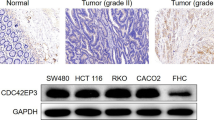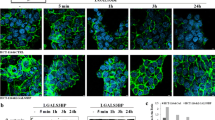Abstract
The present study intends to explore the influence of Lgr5 as a marker of tumor stem cells after siRNA interference on the proliferation and invasion of colorectal carcinoma (CRC) and its mechanism. The tissue samples were taken for biopsy from 32 cases of patients and 32 cases of normal subjects by colonoscopy. Real-time quantitative PCR was used to detect the differential expression of Lgr5. After siRNA interference of Lgr5 in CRC cell line CT-26 cells, RT-PCR method was used to detect the mRNA expression level of Lgr5 after interference of CT-26 cells. CCK8 method was used to observe the influence of Lgr5 interference on the proliferation, colony formation, and invasion of CT-26 cells. RT-PCR and Western blot were used to detect the E-cadherin mRNA and protein levels in CT-26 cells. Lgr5 expression level in CRC tissue was significantly higher than that in the corresponding para-carcinoma tissue and the control group, and the differences were statistically significant (P < 0.05). Lgr5 mRNA expression level in tissue with lymph node metastasis was significantly higher than that in the tissue without lymph node metastasis, and the difference was statistically significant (P < 0.05). Compared with the control group, CT-26 cell proliferation, colony formation, and migration capability after Lgr5 siRNA transfection were all significantly reduced, and the differences were statistically significant (P < 0.05). CT-26 cells after Lgr5 interference were found with significantly reduced E-cadherin mRNA and protein levels. Lgr5 facilitates the cell proliferation, colony formation, and migration of colorectal carcinoma, which may be closely related to the expression level of E-cadherin.


Similar content being viewed by others
References
Yamamoto, Y., Sakamoto, M., Fujii, G., Tsuiji, H., Kenetaka, K., Asaka, M., & Hirohashi, S. (2003). Overexpression of orphan G-protein-coupled receptor, Gpr49, in human hepatocellular carcinomas with beta-catenin mutations. Hepatology, 37, 528–533.
McClanahan, T., Koseoglu, S., Smith, K., Grein, J., Gustafson, E., Black, S., et al. (2006). Identification of overexpression of orphan G protein-coupled receptor GPR49 in human colon and ovarian primary tumors. Cancer Biology & Therapy, 5, 419–426.
Brenner, H., Kloor, M., & Pox, C. P. (2014). Colorectal cancer. Lancet, 383, 1490–1502.
Zheng, Z. X., Zheng, R. S., Zhang, S. W., & Chen, W. Q. (2014). Colorectal cancer incidence and mortality in china, 2010. Asian Pacific Journal of Cancer Prevention, 15, 8455–8460.
Liang, Y., Tang, W., Huang, T., Gao, Y., Tan, A., Yang, X., et al. (2014). Genetic variations affecting serum carcinoembryonic antigen levels and status of regional lymph nodes in patients with sporadic colorectal cancer from Southern China. PLoS One, 9, e97923.
Katoh, Y., & Katoh, M. (2009). Hedgehog target genes: mechanisms of carcinogenesis induced by aberrant hedgehog signaling activation. Current Molecular Medicine, 9, 873–886.
Fan, X. S., Wu, H. Y., Yu, H. P., Zhou, Q., Zhang, Y. F., & Huang, Q. (2010). Expression of Lgr5 in human colorectal carcinogenesis and its potential correlation with beta-catenin. International Journal of Colorectal Disease, 25, 583–590.
Uchida, H., Yamazaki, K., Fukuma, M., Yamada, T., Hayashida, T., Hasegawa, H., et al. (2010). Overexpression of leucine-rich repeat-containing G protein-coupled receptor 5 in colorectal cancer. Cancer Science, 101, 1731–1737.
Takahashi, H., Ishii, H., Nishida, N., Takemasa, I., Mizushima, T., Ikeda, M., et al. (2011). Significance of Lgr5(+ve) cancer stem cells in the colon and rectum. Annals of Surgical Oncology, 18, 1166–1174.
Todaro, M., Francipane, M. G., Medema, J. P., & Stassi, G. (2010). Colon cancer stem cells: promise of targeted therapy. Gastroenterology, 138, 2151–2162.
Mehendiratta, M., Solomon, M. C., Boaz, K., Guddattu, V., & Mohindra, A. (2014). Clinico-pathological correlation of E-cadherin expression at the invasive tumor front of Indian oral squamous cell carcinomas: An immunohistochemical study. Journal Oral Maxillofacial Pathology, 18, 217–222.
Cavalcante, J. R., Sampaio, J. P., Maia Filho, J. T., Vieira, R. B., Eleuterio Junior, J., Lima Junior, R. C., et al. (2014). Progressive loss of E-cadherin immunoexpression during cervical carcinogenesis. Acta Cirurgica Brasileira, 29, 667–674.
Author information
Authors and Affiliations
Corresponding author
Rights and permissions
About this article
Cite this article
Jia, H., Xiang, L., Wang, Z. et al. A Study on the Mechanism of Low-Expressed Cancer Stem Cell Marker Lgr5 in Inhibition of the Proliferation and Invasion of Colorectal Carcinoma. Cell Biochem Biophys 73, 393–397 (2015). https://doi.org/10.1007/s12013-015-0640-6
Published:
Issue Date:
DOI: https://doi.org/10.1007/s12013-015-0640-6




